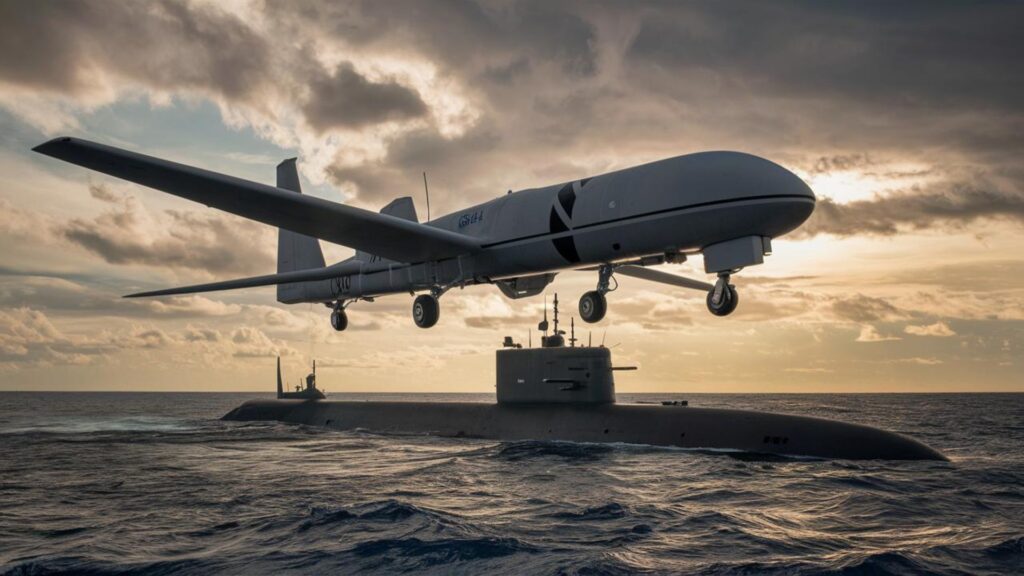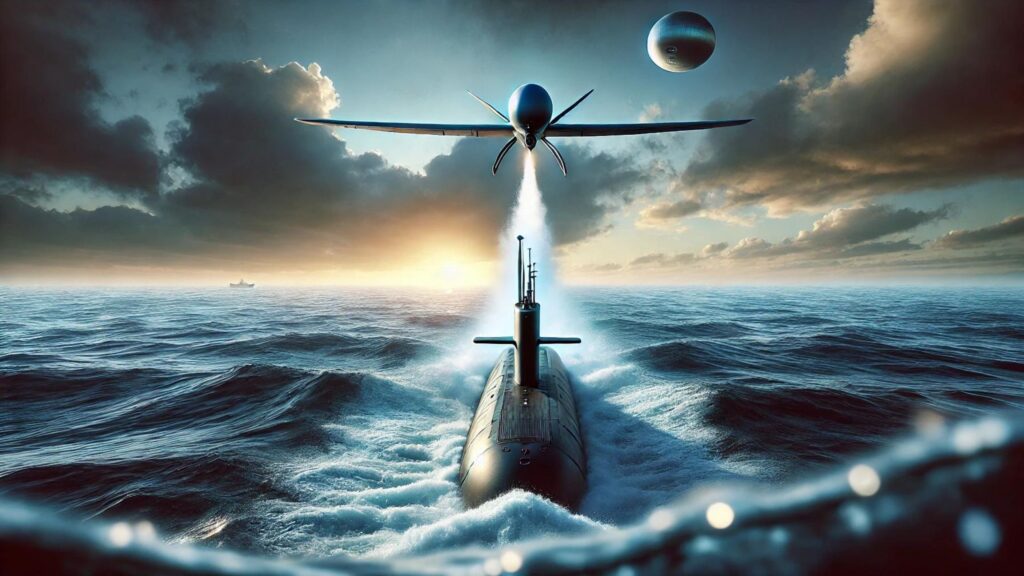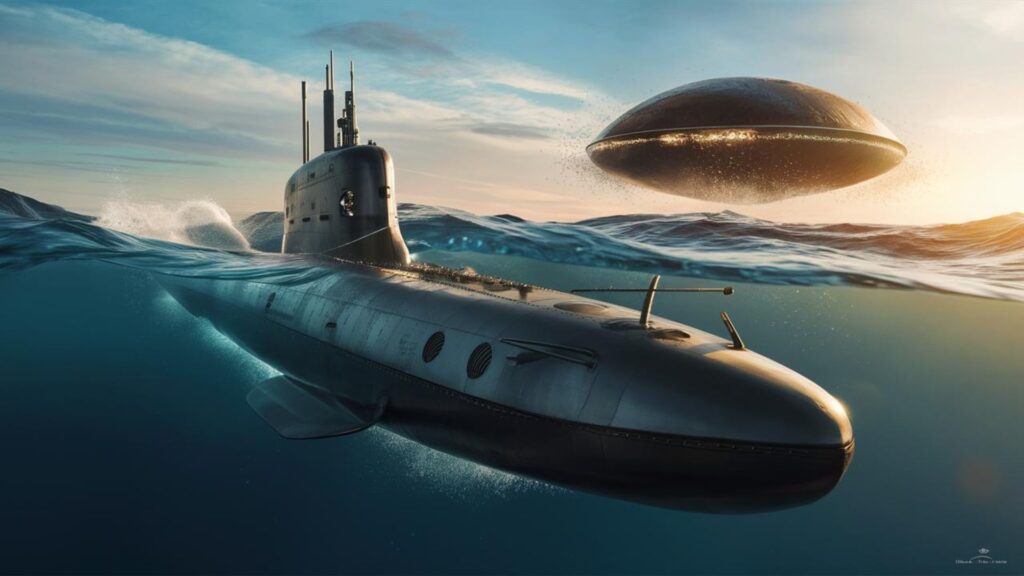In the murky depths of our oceans, a technological revolution is quietly unfolding – one that could have far-reaching implications not just for naval warfare but potentially for our understanding of Unidentified Aerial Phenomena (UAPs). Submarine-launched Unmanned Aerial Vehicles (SLUAVs) represent a cutting-edge fusion of undersea and aerial capabilities, pushing the boundaries of what’s possible in maritime operations. But could this technology also shed light on the enigmatic world of UAPs? Let’s dive deep into this intriguing possibility.
The Silent Revolution Beneath the Waves

For decades, submarines have been the silent sentinels of the seas, conducting covert operations and gathering intelligence from the depths. However, their underwater domain has always imposed limitations on their ability to observe and interact with the world above the surface. Enter SLUAVs – a game-changing technology that promises to extend the reach of submarines far beyond their traditional boundaries.
The Challenge of Taking Flight from the Deep

Launching an aircraft from a submerged submarine is no small feat. The crushing pressures of the deep sea, the absence of a traditional runway, and the need for absolute stealth all pose significant challenges. Yet, the potential benefits are so tantalizing that researchers and military organizations around the world are pouring resources into overcoming these obstacles.
Current solutions like Unmanned Tethered Vehicles (UTVs) and expendable pop-up payloads offer limited capabilities. UTVs, while providing real-time data, are constrained by their tether length. Pop-up payloads, launched from torpedo tubes, offer a one-way trip for reconnaissance but lack the flexibility and reusability desired for extended operations.
Innovations on the Horizon

The future of SLUAVs lies in developing systems that can reliably launch, operate, and recover unmanned aircraft directly from submerged submarines. Some of the most promising areas of research include:
- Submersible UAV Launch Tubes: Imagine a specialized compartment built into the submarine’s hull, housing a watertight launch tube that can protect a UAV during underwater transit and facilitate a smooth transition to airborne flight.
- Underwater Drone Docking Stations: External, hydrodynamic compartments on the submarine’s hull could serve as protected housing for UAVs, allowing for quick deployment while minimizing drag on the submarine itself.
- Compact Folding UAV Designs: Engineers are developing innovative folding mechanisms and utilizing advanced materials to create UAVs that can be stored compactly within a submarine and rapidly deploy into flight-ready configurations.
- Water-Launched Propulsion Systems: Traditional air-breathing engines won’t cut it for underwater launches. Research is focused on electric, hybrid, or specialized propulsion systems that can function in both aquatic and aerial environments.
- Autonomous Launch and Recovery Systems: To maximize efficiency and minimize crew involvement, the goal is to develop fully autonomous systems capable of handling the complex task of deploying and retrieving UAVs in challenging underwater conditions.
The UAP Connection: More Than Meets the Eye?

Now, you might be wondering – what does all this submarine technology have to do with UAPs? The connection may be more significant than it first appears.
Underwater Origins of UAPs?
For years, UFO researchers have reported strange phenomena not just in our skies but also emerging from and disappearing into our oceans. The term “USO” (Unidentified Submerged Object) has gained traction in the UFO community to describe these aquatic anomalies. Could some UAP sightings actually be misidentified glimpses of advanced SLUAV technology?
Consider this: In 2004, during the now-famous “Nimitz Encounter,” Navy pilots reported seeing an unusual object descend from high altitude to hover just above the ocean surface in a matter of seconds. Even more intriguingly, crew members aboard the USS Princeton reported tracking objects on radar that appeared to drop from the sky into the ocean or rise from the water into the air at incredible speeds.
While it’s crucial to note that the capabilities described in the Nimitz Encounter far exceed any known SLUAV technology, these reports highlight the potential for confusion between advanced military hardware and truly unexplainable phenomena.
The Black Budget and Hidden Technologies

It’s no secret that military research and development often occur years, if not decades, ahead of what’s known to the public. The infamous “black budget” – classified spending on covert projects – provides ample funding for the development of technologies that push the boundaries of what we consider possible.
In fiscal year 2023, the U.S. military requested approximately $27.6 billion for its classified “black budget” programs. While much of this likely goes toward traditional defense and intelligence capabilities, it’s not unreasonable to speculate that some of these funds could be directed toward highly advanced UAV and SLUAV technologies.
Stealth and Deception: A Perfect Cover?
The very nature of submarine operations – stealth, secrecy, and deniability – makes them an ideal platform for testing and deploying cutting-edge technologies away from prying eyes. If a highly advanced SLUAV were to be spotted during testing or covert operations, it could easily be dismissed as a UAP, providing perfect cover for classified military activities.
This possibility raises intriguing questions:
- Could some UAP reports be the result of misidentified SLUAV test flights?
- Might the government’s recent acknowledgment of UAP encounters be a calculated move to maintain plausible deniability for advanced aerospace technologies?
- Is it possible that some “disclosure” efforts are actually carefully orchestrated disinformation campaigns designed to muddy the waters around classified military capabilities?
The Technical Marvels: Blurring the Lines Between Science Fiction and Reality

Let’s explore some of the specific technologies being developed for SLUAVs that could potentially be mistaken for otherworldly capabilities if encountered by unsuspecting observers.
Metamaterials and Adaptive Camouflage
One of the holy grails of SLUAV development is creating vehicles that can seamlessly transition between water and air while remaining virtually undetectable. Research into metamaterials – artificially engineered materials with properties not found in nature – could potentially yield breakthroughs in this area.
Imagine a UAV coated in a smart material that can instantly adapt its optical and radar properties to match its surroundings. Such a vehicle could appear to “vanish” as it transitions from air to water or vice versa, potentially explaining some reports of UAPs that seem to disappear or materialize suddenly.
Antigravity Propulsion: Science Fiction or Classified Reality?

While conventional wisdom holds that antigravity propulsion is purely in the realm of science fiction, there have been persistent rumors and patents suggesting that research into gravity manipulation is ongoing. In 2016, a controversial patent application filed by a U.S. Navy researcher described a theoretical “hybrid aerospace-underwater craft” utilizing an “inertial mass reduction device” to reduce its effective mass and enable incredible maneuverability in both air and water.
While the feasibility of such technology remains hotly debated, its mere existence as a patent raises questions about the potential for revolutionary propulsion systems that could be mistaken for UAP if deployed covertly.
Quantum Radar and Advanced Sensors
Traditional radar systems struggle to detect stealthy or hypersonic targets. However, research into quantum radar technology promises to overcome these limitations. By utilizing entangled photons, quantum radar could theoretically detect even the most advanced stealth aircraft or underwater vehicles.
If SLUAVs were equipped with early prototypes of such sensors, they might exhibit tracking and targeting capabilities far beyond what’s publicly known to be possible. To an observer unaware of these advancements, such performance could appear to be evidence of non-human technology.
The Geopolitical Chessboard: UAPs as a Smokescreen?

The development of SLUAVs isn’t happening in a vacuum. As tensions rise between global powers, particularly in regions like the South China Sea, the race for undersea dominance is heating up. Could the recent uptick in official acknowledgment of UAP encounters be part of a larger geopolitical strategy?
Misdirection and Uncertainty
By allowing (or even encouraging) speculation about extraterrestrial origins for some UAP sightings, military powers could be creating a convenient smokescreen for the testing and deployment of classified aerospace technologies. This strategy of “hiding in plain sight” could provide plausible deniability while also sowing confusion among potential adversaries.
The Underwater Arena
The world’s oceans are becoming an increasingly contested space. As of 2021, China’s submarine fleet numbered approximately 79 vessels, while the U.S. Navy operated around 68 submarines. However, raw numbers don’t tell the whole story – technological superiority in areas like SLUAVs could provide a decisive edge in future conflicts.
By blurring the lines between UAP encounters and classified military operations, nations could be testing the waters (quite literally) of their adversaries’ detection capabilities and response protocols.
Implications for UFO Research and Disclosure Efforts

For those of us dedicated to uncovering the truth about UAPs and potential extraterrestrial visitation, the emergence of SLUAV technology presents both challenges and opportunities.
The Need for Critical Analysis
As SLUAV capabilities advance, it becomes increasingly important for UFO researchers to develop a nuanced understanding of cutting-edge aerospace technologies. This knowledge is crucial for distinguishing between potential breakthrough human-made craft and truly anomalous phenomena that defy conventional explanation.
The Disclosure Dilemma
The possibility that some UAP encounters could be misidentified glimpses of classified SLUAV technology complicates efforts toward full government disclosure. If military leaders believe that maintaining ambiguity around UAPs provides strategic cover for their own advanced technologies, they may be incentivized to perpetuate uncertainty rather than provide clear answers.
A New Frontier for Investigation
The undersea dimension of UAP phenomena remains relatively unexplored compared to aerial sightings. As interest in SLUAVs grows, UFO researchers may find fertile ground for investigation by focusing on the interface between our oceans and skies. Collaborations with marine scientists, oceanographers, and experts in submarine technology could yield valuable insights.

As we’ve explored in this deep dive, the world of submarine-launched UAVs is a fascinating realm where cutting-edge technology, military strategy, and the enduring mystery of UAPs intersect. While it’s crucial to approach these connections with a critical eye and healthy skepticism, the potential implications are too significant to ignore.
The development of SLUAVs represents a revolutionary leap in maritime capabilities, one that could reshape our understanding of both underwater warfare and unidentified aerial phenomena. As these technologies continue to evolve, they challenge us to expand our perspectives and consider possibilities that may have once seemed confined to the realm of science fiction.
For UFO enthusiasts and researchers, the emergence of SLUAVs offers both a cautionary tale and an exciting new avenue for investigation. It reminds us of the importance of staying informed about advancements in aerospace and military technology while also reinforcing the notion that some of the most intriguing mysteries may lie not in the skies above but in the unexplored depths of our own oceans.
As we continue to push the boundaries of what’s possible beneath the waves and above the clouds, one thing remains certain: the truth is out there, and it may be more complex and fascinating than we ever imagined.
